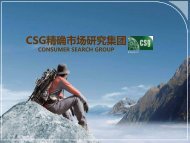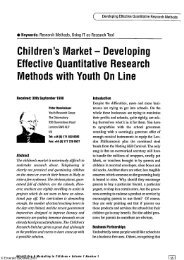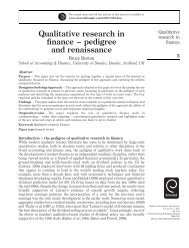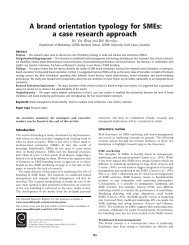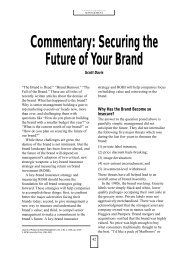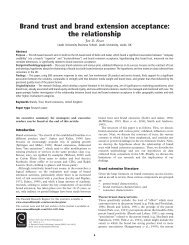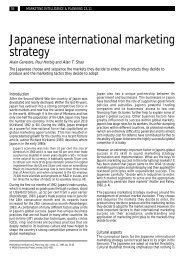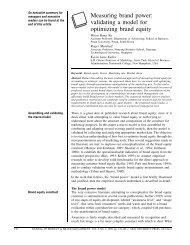Internationalizing quantity surveying services - Emerald
Internationalizing quantity surveying services - Emerald
Internationalizing quantity surveying services - Emerald
Create successful ePaper yourself
Turn your PDF publications into a flip-book with our unique Google optimized e-Paper software.
The current issue and full text archive of this journal is available atwww.emeraldinsight.com/0969-9988.htmECAM15,5440Received December 2007Revised May 2008Accepted June 2008<strong>Internationalizing</strong> <strong>quantity</strong><strong>surveying</strong> <strong>services</strong>Florence Yean Yng LingDepartment of Building, National University of Singapore, Singapore, andAmy Hui Min ChanDavis Langdon and Seah, SingaporeAbstractPurpose – With the advent of globalization, consultancy firms could easily offer <strong>services</strong> outsidetheir home countries. This study aims to investigate how <strong>quantity</strong> <strong>surveying</strong> (QS) firms in Singaporeinternationalize their <strong>services</strong>, by examining the unique characteristics of exporting firms, the forcesthat drive them to export and the strategies they adopt in internationalization.Design/methodology/approach – The research method is based on a structured questionnaire anddata were collected via postal survey. Questionnaires were sent to all 47 QS firms operating inSingapore. A total of 25 responses were received.Findings – The results show that QS firms that offer <strong>services</strong> overseas have more staff thannon-exporters, handle larger projects and offer a wider range of <strong>services</strong>. In addition, these firms arefocused on generating additional revenue and conduct their own market research to secure overseascontracts. They enter foreign countries first as wholly owned foreign subsidiaries and later on formjoint ventures with firms in the host country.Originality/value – The finding suggests that to internationalize, firms need to be of a critical size interms of staff strength. They must offer integrated and other value added <strong>services</strong>. To secure moreoverseas projects, firms should undertake aggressive marketing, collect market data in host countries,instead of relying on published information. Many projects were won through past and present clients’recommendations. To win more overseas contracts, it is recommended that QS firms form closerelationships with clients who are best placed to give referrals or repeat business.Keywords Construction industry, Market entry, Quantity <strong>surveying</strong>, SingaporePaper type Research paperEngineering, Construction andArchitectural ManagementVol. 15 No. 5, 2008pp. 440-455q <strong>Emerald</strong> Group Publishing Limited0969-9988DOI 10.1108/09699980810902730IntroductionAs a member of the World Trade Organization and with the ratification of numerousfree trade agreements, Singapore firms are able to engage in the exchange of goods and<strong>services</strong> across international boundaries. This trend is accentuated by its smalldomestic market. Its domestic construction market has an annual value of contractsawarded averaging S$13.4 billion (S$1 < US$0.60) between 2000 and 2005 (Buildingand Construction Authority, 2005). Therefore, it is necessary for its consultancy andcontracting firms to export their <strong>services</strong>. One group of exporters are consultant<strong>quantity</strong> <strong>surveying</strong> (QS) firms. With the importance of exporting, it is necessary toinvestigate how QS firms in Singapore internationalize their <strong>services</strong>.The objectives of this study are:.to compare exporters and non-exporters to determine if exporting QS firmspossess special qualities that enable them to export their <strong>services</strong>;
Non-exporter(n ¼ 9) Equality of meanExporter(n ¼ 16)Sig.(1-tailed) t-value Sig.Sig.(1-tailed) Rank Mean t-valueRef. Aim of firm Rank Mean t-valueA1 Generate additional revenue 1 6.190 11.667 0.000 * 4 5.110 2.857 0.011 * 7.942 0.010 *A2 Stabilize revenue fluctuation 9 4.880 1.962 0.035 * 6 5.000 2.683 0.014 * 0.036 0.851A3 Increase client base 3 5.880 6.228 0.000 * 1 5.560 4.128 0.002 * 0.423 0.522A4 Increase profits 2 6.000 6.928 0.000 * 2 5.440 3.506 0.004 * 1.269 0.272A5 Increase organizational capabilities 4 5.810 5.461 0.000 * 3 5.220 3.051 0.008 * 1.215 0.282A6 Learn new technologies 8 5.310 3.882 0.001 * 7 4.440 1.835 0.052 3.153 0.089A7 Broaden organizational skills 6 5.750 7.000 0.000 * 4 5.110 4.264 0.002 * 2.719 0.113A8 Increase geographical spread 4 5.810 5.461 0.000 * 9 3.890 20.175 0.433 8.860 0.007 *Note: * Significant at 95 percent confidence levelQuantity<strong>surveying</strong><strong>services</strong>443Table II.Internal factors drivinginternationalization (A)
ECAM15,5444Marketing strategies (cell E)The aim of marketing is to understand needs of clients through objective andperspective analyses on how clients can benefit from the <strong>services</strong> offered, and in turnmake sure clients are aware of the potential benefits (Bower, 1968). Marketing shouldemphasize the importance of customer retention and customer relationship economics,also known as relationship marketing (RM), which revolves around concern, trust,commitment and service. Low and Tan (2002) found that gaining repeat business,building customer loyalty and gaining referrals from existing clients are very crucial toQS firms in general.Francis and Collins-Dodd (2000) found that the best approach to generating sales inforeign markets involves forming personal contacts and relationships in foreignmarkets. Reliance on distant third parties such as government and industry leads, isinsufficient. Firms need to mount their own marketing activities abroad rather thandepend on domestic-based marketing efforts.From the literature, various marketing strategies were identified (Table V). In thefieldwork, these variables were tested for their applicability to exporting QS <strong>services</strong>.Business strategies (cell F)Porter (1980) theorized that managers must choose between the two basic strategies ofincreasing the value of an organization’s products: differentiating the product to addvalue or lowering the costs of value creation. Differentiation strategy usually involveshaving a core competence that competitors cannot easily match or imitate (Hamel andPrahalad, 1994). In international construction, differentiation strategy involvesproviding specialty or superior quality products or <strong>services</strong>. The low cost strategy maybe achieved if firms establish price competitiveness. Besides achieving competitiveadvantage over competitors, other business strategies that may be considered by QSfirms when exporting are given in Table VI. These variables were tested in thefieldwork for their applicability to internationalization of QS <strong>services</strong>.Ref Source No. %Table III.Sources of exportinformation (C)C1 Own market research 15 93.75C2 Contacts in the field (other consultants, clients, other QS firms) 13 81.25C3 External professional advisers 7 43.75C4 Government/industry leads or contacts (BCA, SISV etc.) 6 37.50C5 Local development agencies 6 37.50Note: Many firms use more than one source of informationRef Entry mode No. %Table IV.Market entry modes (D)D1 Set up a branch office (office part of parent company) 6 37.50D2 Set up a new subsidiary firm (separate legal entity from parent company) 5 31.25D3 Joint venture with a firm in host country 5 31.25D4 Joint venture with a firm in Singapore 0 0.00D5 Merge with a firm in host country (to create new legal entity) 0 0.00D6 Merge with a firm in Singapore (to create new legal entity) 0 0.00
Ref Strategy Rank Mean T-valueSig.(1 tailed)E1 Ensure high degree of customer awareness of the firm 6 6.000 5.314 0.000 *E2 Rely on word of mouth 3 6.190 11.667 0.000 *E3 Establish good relationship with client 3 6.190 6.591 0.000 *E4 Establish good image and reputation in the minds ofE5client 1 6.500 13.693 0.000 *Acquire market-sensing ability to gather competitorinformation 8 5.130 3.000 0.005 *E6 Rely on recommendation by clients 1 6.500 19.365 0.000 *E7 Rely on recommendation by other consultants 7 5.940 11.396 0.000 *E8 Rely on recommendation by contractors 8 5.130 2.915 0.006 *E9 Rely on repeat business 3 6.190 5.775 0.000 *Note: * Significant at 95 percent confidence levelQuantity<strong>surveying</strong><strong>services</strong>445Table V.Marketing strategies (E)Ref Description Rank Mean T-valueSig.(1 tailed)F1 Expand scope of <strong>services</strong> to cater to foreign marketdemand 3 5.310 3.626 0.001 *F2 Achieve competitive advantage over competitors 2 5.880 6.228 0.000 *F3 Expand firm by increasing number of staff to developscope of <strong>services</strong> 5 5.060 2.573 0.011 *F4 Expand firm (scope of <strong>services</strong> and staff strength)gradually through the years 3 5.310 3.085 0.004 *F5 Improve firm’s capabilities to meet customer’s needs 1 6.060 9.661 0.000 *Note: * Significant at 95 percent confidence levelTable VI.Business strategies (F)Knowledge gapPrevious studies on internationalization have focused on architectural, engineering andconstruction (AEC) firms. Han and Diekmann (2001) investigated AEC firms’ go/no-godecisions in international projects. Ling et al. (2005a) investigated AEC firms’ entry andbusiness strategies. This study aimed to fill the gap by focusing on QS <strong>services</strong> andhow QS firms internationalize their <strong>services</strong>. QS <strong>services</strong> are different from AEC<strong>services</strong> because they focus on contractual and cost management, instead of design orphysical construction.Research methodThe quantitative research method was adopted in this study because objective realitycan be captured and translated into testable hypotheses through statistical analyses.The exploratory study adopted the opinion research approach. This was selectedbecause respondents who had exported QS <strong>services</strong> were considered experts and theiropinions would be useful. The postal survey data collection technique was employedbecause this allowed many sets of data to be collected in a systematic manner over a
ECAM15,5446relatively short period of time. Statistical analyses involving univariate and bivariateanalyses were conducted to analyze the data collected.The postal survey was based on a structured questionnaire that consisted of threesections. Section A was to ascertain demographic characteristics. It also requiredrespondents who had exported to indicate the sources of information for theinternational market and types of foreign market entry modes adopted. Section Bfocused on endogenous and exogenous factors driving internationalization. Exportersproceeded to section C to rate the extent to which certain characteristics helped theirfirms win overseas projects, and the importance of marketing and business strategies.For sections B and C, each respondent was asked to rate the extent to which eachstatement represented the position of his company on a seven-point Likert scale, where1 ¼ does not describe the firm’s position at all/disagree; 4 ¼ neutral and 7 ¼ describesthe firm’s position to a great extent/agree.A pilot study was conducted which led to a few minor adjustments to thequestionnaire. The finalized package consisted of the questionnaire and a cover letterexplaining the study’s purpose, a self addressed and stamped envelope, and a requestform for a summary of the research results. This was to encourage respondents to takepart in the study so as to increase the response rate. It was self-administered, whichprecluded verification of responses.Data collection was by means of a postal survey, targeted at all 47 (total population)listed consultant QS firms in Singapore. This was followed by an e-mail reminder andtelephone calls.Data analysisT-test of the mean was carried out with the help of the Statistical Package for SocialSciences (SPSS) software to find out whether the population would agree that thevariable is significant in internationalization. For each attribute, the null hypothesisthat the attribute did not play a role in internationalization, and the alternativehypothesis that the attribute played a role are set out below:.Null hypothesis H 0 : m # m 0 ..Alternative hypothesis H 1 : m . m 0 .Where m was the population mean. The decision rule was to reject H 0 when p , 0.05.In this study, m 0 was fixed at 4 because by definition given in the rating scale, ratingsabove 4 (i.e. 5, 6 and 7) represented respondents’ agreement or company practice. Thismeant that if the calculated p value is smaller than 0.05, the null hypothesis that theattribute did not reflect the firm’s practice was rejected and the alternative hypothesiswas accepted. It was then concluded that the attribute reflected the position of firmsregarding internationalization.To compare the characteristics of exporters (group 1) and non-exporters (group 2),t-test of equality of means was conducted. In this test, H 0 : m 1 ¼ m 2 ; and H 1 : m 1 – m 2 ,where H 0 : there is no significant difference between exporters and non-exporters; andH 1 : there is a significant difference between exporters and non-exporters.
Results and discussionDegree of internationalizationQuestionnaires were sent to all 47 QS firms operating in Singapore, addressed to themanaging director and senior partner. Within one month, 20 responses were received.After two reminders, five more responses were received. The 25 sets of datarepresented a response rate of 53 percent.Of the 25 responses, 16 firms (64 percent) were actively exporting their <strong>services</strong>(exporters), and nine firms (36 percent) were not (non-exporters). As 22 other firms didnot respond (being 47-25), it was necessary to investigate the export status of thesenon-respondents. The research made an assumption that the five late respondentscould represent those who did not respond. A closer examination of the five laterespondents revealed that they were non-exporters. This could mean that in thepopulation of 47 firms, 16 (34 percent) and 31 (66 percent) firms were exporters andnon-exporters respectively, indicating that internationalization is still not widespreadamong consultant QS firms as yet.All exporters had handled projects in Asean and 81 percent of them had alsohandled projects in China and Taiwan (see Table VII). The finding shows that the mostfavorable region for exporting QS firms is Southeast Asia, because of its geographicalproximity to Singapore, familiarity and similarities in cultures and more importantlythe abundance of construction opportunities as a result of increasing economicactivities in these developing countries. China is also a popular place to conductbusiness as it attracts a large amount of foreign direct investment. Moreover, Chinaand Singapore share similarities in culture, with the majority of the population beingChinese. The results also show that QS firms did not venture beyond Southeast andNortheast Asia.Quantity<strong>surveying</strong><strong>services</strong>447Characteristics of exporters and non-exportersTable VII summarizes the characteristics of respondents. The majority of them weretop management who had more than 20 years of experience in the industry. Exportingand non-exporting firms had average 3.75 and 1.89 partners respectively. Statisticaltest revealed that there is no significant difference (t ¼ 2:051, p ¼ 0:052) between themean number of partners in each type of firm, indicating that the number of partnersdoes not help or hinder a QS firm’s internationalization effort.Non-exporters undertook small and medium sized projects while exporters did nothandle small projects costing less than S$1 million. This may pose a problem tonon-exporters when they attempt to penetrate international markets because theirlimited track record in terms of project size may not be favored by international clients.Besides undertaking the usual QS <strong>services</strong>, both groups of respondents providedother related <strong>services</strong>. Table VII shows a larger percentage of exporters thannon-exporters providing other <strong>services</strong> such as construction management, contractmanagement, project management, project coordination, and being clients’representatives. The results show that exporting firms have a wider scope of<strong>services</strong> compared to non-exporters.Among exporting firms, the majority of them had more than nine years of exportexperience and derived less than 40 percent of their revenue from overseas projects.Exporters still obtain most of their revenues from the domestic market.
ECAM15,5448Exporters(n ¼ 16)Non-exporters(n ¼ 9) OverallRespondents’ characteristics n % n % n %Designation (current)Top management 14 87.50 8 88.89 22 88.00Middle management 2 12.50 1 11.11 3 12.00Years in industryUp to 10 years 1 6.25 0 0.00 1 4.0011-20 years 7 43.75 3 33.33 10 40.00.20 8 50.00 6 66.67 14 56.00Mean 21.44 26.67 23.32Workforce1-9 employees 8 50.00 9 100.00 17 68.0010-100 employees 7 43.75 0 0.00 7 28.00.100 employees 1 6.25 0 0.00 1 4.00Mean 47.97 6.33 32.98No. of partners1 partner (sole proprietor) 6 37.5 4 44.44 10 40.002-5 partners 5 31.25 5 55.56 10 40.006-10 partners 4 25.00 0 0.00 4 16.00.10 partners 1 6.25 0 0.00 1 4.00Median 3 2 2Mean 3.75 1.89 3.08Usual value of projects handled, S$1 million 0 0.00 4 44.44 4 16.00S$1 million-S$30 million 8 50.00 2 22.22 10 40.00. S$30 million 8 50.00 3 33.34 11 44.00Services providedQuantity <strong>surveying</strong> 16 100.00 9 100.00 25 100.00Construction management 6 37.50 2 22.22 8 32.00Contract management 10 62.50 2 22.22 12 48.00Project management 11 68.75 3 33.33 14 56.00Project co-ordination 4 25.00 0 0.00 4 16.00Employer’s representative in D&B contracts 6 37.50 2 22.22 8 32.00Others 3 18.75 0 0.00 3 12.00Number of years of export experience1-9 4 25.00 – –10-19 5 31.25 – –20-29 4 25.00 – –30-39 1 6.25 – –Unknown 2 12.50 – –Table VII.Characteristics ofrespondents and theirfirmsPercentage of export revenue to Total Revenue (%)1-9 2 12.50 – –10-19 2 12.50 – –(continued)
Exporters(n ¼ 16)Non-exporters(n ¼ 9) OverallRespondents’ characteristics n % n % n %20-29 6 37.50 – –30-39 2 12.50 – –Unknown 4 25.00 – –Quantity<strong>surveying</strong><strong>services</strong>449Export destinationASEAN 16 100 – –China and Taiwan 13 81.25 – –India and Sri Lanka 6 37.5 – – Table VII.Table I shows exporters’ ratings on factors that they perceived help them win overseasprojects. The top three factors are past experience in overseas projects (SQ1); success indomestic market (SQ2); and size of projects handled (SQ3). These relate todemonstrated knowledge and know-how, indicating that clients believe that morejob experience will lead to higher job performance. Job experience shows that theconsultant has technical experience, managerial experience and professionalexperience, which are accumulated on a long-term basis (Kirmani and Baum, 1992).Large sized QS firms (SQ4) boost clients’ confidence to award projects to them. Thiscorroborates the profile of staff strength in Table VII, where exporters(average ¼ 47:97) and non-exporters (average ¼ 6:33) had significantly differentnumber of employees (t ¼ 2:759, p ¼ 0:013). The finding suggests that firms that arebigger are more likely to internationalize. However, do they internationalize becausethey are big or do they become big as they internationalize? A check of the larger firmsin the sample showed that QS firms grew large gradually in the domestic market. Theythen internationalize their <strong>services</strong>. When firms have more employees, wider range anddepth of skills and expertise are available. These help in a firm’s expansion to foreignmarkets.The results in Table I show that exporters do not accord significant importance tobeing a subsidiary of a reputable parent company (SQ6). This may be because clientsare working with an individual and not the company per se. Personal reputation of therepresentative of the company is more relevant than the reputation of the company.Objective 1 of this study was to compare the characteristics of exporting andnon-exporting firms. From the above findings, it can be concluded that exporting QSfirms are those that have more employees, handle larger projects and offer a widerscope of <strong>services</strong>. When undertaking overseas projects, exporters prefer locationscloser to home or those that have more cultural similarities with. Exporters’ good trackrecord provides evidence to international clients that they can perform well.Endogenous (A) and exogenous factors driving exports (B)Table II shows the respondents’ ratings for endogenous factors driving exports. Theresults reveal that the main internal drivers for exporting are to generate additionalrevenue (A1) and increase profits (A4). Exporters and non-exporters also rated theseinternal factors as important in driving exports: stabilizing revenue fluctuation (A2);
ECAM15,5450increasing client base (A3); increasing organizational capabilities (A5); and broadeningorganizational skills (A7).There were several differences between perceptions of exporters and non-exporters.Firstly, exporters attached significantly more importance to generating additionalrevenue (A1) than non-exporters (t ¼ 7:942, p ¼ 0:010). Past studies (e.g. Langford andRowland, 1995) have focused on increasing profit instead of increasing revenue, as thepurpose of internationalizing. The desire to increase long-term profitability motivatesfirms to consider being involved in the international stage (Imbert, 1990).Secondly, exporters regarded learning new technologies (A6) as significantlyimportant, unlike non-exporters. This may be because non-exporters felt the cost ofimplementing new technologies is a burden on their small companies. On the otherhand, exporters realized that technology supremacy can enhance workmanship andarchitectural quality (Ling et al., 2006; ASCE).Thirdly, exporters indicated that they are interested in increasing geographicalspread by moving into foreign markets (A8) while non-exporters are not.Non-exporters may have the psychological barrier that caused them to viewuncertainties associated with foreign market expansion negatively (Burpitt andRondinelli, 1998).Table VIII shows that the top three forces driving internationalization effort ofexporters are: solid foreign market demand (B3), opportunities for growth lie overseas(B2), and saturation in home market (B4). An example of solid foreign market demandis the Middle East, brought about by increasing oil prices leading to budget surplus,and increased expenditure in construction and infrastructure development. Thenumber of construction consultancy firms from Singapore entering the Middle Eastalso increased in tandem (Building and Construction Authority, 2006).Besides solid overseas demand, firms may export because they perceive that mostattractive opportunities for growth lie in overseas markets. Positive perceptions ofexport possibilities are positively correlated to a firm’s propensity to export (Francisand Collins-Dodd, 2000).Exporters did not rely on government incentives (B1) to export. This may bebecause handouts from the government are privileges that could be withdrawnunilaterally. It is more sensible to develop strong capabilities and improving the scopeand quality of <strong>services</strong> to meet overseas clients’ needs.Objective 2 of this study was to identify internal and external factors drivinginternationalization. The results from Tables I and II show that firms need to havestrong internal motivation to increase revenue and profits, and strong external pullfrom solid overseas demand to drive them to export.Obtaining market intelligence (C)Figure 1 shows that after firms have decided to export, they need to obtain marketinformation (cell C) relating to where these projects are. From Table III, it is observedthat there are several methods and most exporters rely on their own market research(94 percent) or contacts in the field (81 percent). The importance of contactsunderscores the role that networking play in international construction. This confirmsLing et al.’s (2005b) study which found that good networks in host countries help firmswin projects. Market research for upcoming projects must be conducted in the host
Exporter (n ¼ 16) Non-exporter (n ¼ 9)Equality ofmeanRef. Motivation for exporting Rank Mean t-value Sig. (1-tailed) Rank Mean t-value Sig. (1-tailed) T-value Sig.B1 There are government incentives 4 4.380 0.792 0.220 4 3.670 20.485 0.321 0.757 0.393B2 Most attractive opportunities for growth lie inoverseas market 2 5.250 3.596 0.002 * 3 3.780 20.336 0.373 4.742 0.040 *B3 There is solid foreign market demand 1 5.750 4.719 0.000 * 1 4.440 0.710 0.249 3.688 0.067B4 There is saturation in home market 3 5.130 2.577 0.011 * 1 4.440 0.645 0.269 0.767 0.390Notes: * Significant at 95 percent confidence levelQuantity<strong>surveying</strong><strong>services</strong>451Table VIII.External forces drivinginternationalization (B)
ECAM15,5452country, rather than from the home country so that current insiders’ information can beobtained.The results show that not many exporters rely on professional advisers (C3) or otherformal modes of information dissemination such as from government bodies (C4). Thissuggests that government departments set up mainly to gather market intelligencemay be wasting tax payers’ money. It may be better if resources can be channeled tohelp firms build up their own market research units.Foreign market entry modes (D)Figure 1 shows that when a firm is ready to internationalize its <strong>services</strong>, it should selecta mode to enter the foreign market (cell D). Table IV shows three methods are adoptedby exporters: set up a branch office (38 percent); set up a new subsidiary firm (31percent); and joint venture with a firm in host country (31 percent).A firm usually enters as a branch office (D1), to get to know the market. When itappears that it is likely to secure projects, it may then set up a new legal entity byforming a subsidiary firm (D2), so that the risks and losses of the subsidiary firmwould not affect the holding firm in the home country. When there are more contracts,having a permanent subsidiary firm is important because clients would expect toconfer with the representatives of the QS firm on a more regular basis, which makeslong distance traveling impractical and costly. Forming a subsidiary firm also givesthe partners of the subsidiary a sense of ownership that makes them more committedto running the business.The results show that joint ventures with a firm in the host country (D3) will allow aconsultant QS firm to learn and adapt to the foreign environment and practices moreeasily. It can tap on the partner’s knowledge of the local market such as local laws,regulations, prices, practices and culture. This could reduce the risk exposure,especially if it is just a one-off project. Joint venturing with a firm from the host countrycan also boost the confidence of clients. This is because besides having superiorinternational expertise, the alliance is familiar with the conditions in the host country.The results indicate that exporters do not accord importance to entry modes thatinvolve joint venturing with another home country firm (D4), as two parties that areunfamiliar with the overseas market may face many learning curve difficulties.Mergers (D5 and D6) are also not favored because they are very costly and risky andbring with them additional problems such as trying to marry divergent corporatecultures (Hill and Jones, 1995).Marketing strategies (E)Table V shows that exporters felt that all the nine marketing strategies are effective( p , 0.05). The results show that exporters win overseas projects by relying on clients’recommendations (E6), establishing good image and reputation in clients’ minds (E4),and establishing good relationships with clients (E3). The findings agree with Low andTan (2002) who also found the importance of building customer loyalty throughrelationship marketing. Clients have been found to seek partners whom they have goodcollaboration experience with in the past (Jin and Ling, 2006; ASCE).The implication of the finding is that interaction with clients is an extremelyimportant aspect of marketing, as clients are the ones who appoint <strong>quantity</strong> surveyors.To win projects, QS firms could undertake marketing in the host country or follow
clients from the home country who invest overseas. It is less tedious as compared to thecompany entering the foreign market by itself.QS firms also rely on repeat business (E9) and word of mouth (E2) to win overseascontracts. These confirm the importance of good track record and reputation (Linget al., 2005b). Firms with good track record could be expected to perform well becausethey do not want to damage their reputation and risk alienation (Provan, 1993).Business strategies (F)Figure 1 shows that besides obtaining market information (cell C), selecting marketentry mode (D) and implementing marketing strategies (E), QS firms need toimplement suitable business strategies (F) in their quest for internationalization.Table VI shows that the respondents perceived that all the strategies are significant inhelping firms win projects overseas ( p , 0.05).The most important strategy is to improve the QS firm’s capabilities to meetcustomers’ needs (F5). Firms must have the capabilities to handle different types ofjobs. If they lack the expertise, they should expand their scope of <strong>services</strong> (F1). Oneexample is clients’ preference for a single company to be responsible for the wholeproject. This implies that the firm must be prepared to provide integrated <strong>services</strong>rather than traditional QS service alone.To expand a firm’s scope of <strong>services</strong> (F1), the results show that firms prefer to dothis by increasing the number of employees (F3) gradually through the years (F4).Table VI shows that achieving competitive advantage over competitors (F2) is animportant business strategy. According to Porter (1980), this can be achieved throughcost leadership or differentiation. For QS firms, cost leadership may be realizedthrough downsizing, multitasking or even outsourcing when it is cheaper to do so. Forfirms that adopt differentiation strategy, they would need to improve the quality oftheir <strong>services</strong>.Quantity<strong>surveying</strong><strong>services</strong>453LimitationsThis study was based on the response of 25 QS firms in Singapore. While this figureappears small, it represents 53 percent of the registered QS firms in Singapore. Thestudy investigated QS firms’ internationalization efforts but did not examine howsuccessful the endeavor was. It is possible that those who had exported their <strong>services</strong>did not derive higher profitability. However, this is not expected to be the majority’ssituation since Table VIII showed their keenness to expand overseas.ConclusionThis study investigated Singapore-based QS firms’ internationalization strategies andpractices. The first objective was to compare exporters and non-exporters to determinequalities and characteristics that exporting QS firms possess that enable them toexport their <strong>services</strong>. The findings showed that non-exporters lagged behind exportersin the following aspects: fewer employees hired, smaller value of projects undertakenand limited scope of <strong>services</strong>. The finding suggests that to internationalize, firms needto be of a critical size in terms of staff strength. Table VII shows an average staffstrength of 48 employees for exporters. With more staff, these firms are also better ableto meet international clients’ needs of integrated <strong>services</strong>, instead of merely offering
ECAM15,5454run-of-the-mill QS <strong>services</strong>. Other value added <strong>services</strong> to be offered include claimsconsultancy and value management.The second objective was to internal and external drivers for exporting QS <strong>services</strong>.The findings showed that exporting and non-exporting firms had the same aims:increase revenue and profits. The main difference was exporters also want to learn newtechnologies, while non-exporters do not. The inference is that learning organizationshave propensity to internationalize because they continue to improve.The third objective was to identify approach in internationalization. Severalmethods are used to find out up-and-coming projects in the overseas pipeline, but themost reliable is still the company’s own market research instead of relying onpublished information. The inference is that by the time the project is reported eitherby government agencies or professional advisers, it may be too late to clinch the job. Itis recommended that firms that are interested in securing overseas projects shouldcollect market data in host countries, instead of relying on published information.As regards foreign market entry mode, QS firms could set up branch offices first,and when the likelihood of winning projects is high, proceed to set up subsidiary firmsto reduce the risk on the head office. It is recommended that foreign firms seriouslyconsider forming joint ventures with local firms that are knowledgeable of the locallaw, supply chain and networks.The study showed that QS firms need to undertake aggressive marketing topenetrate foreign markets. Many projects were won through past and present clients’recommendations. This indicates the need to constantly establish good relationshipsand good image with clients and treat them as potential source of future business. Thefindings also revealed the importance of meeting customers’ needs by improving one’scapabilities and having an edge over competitors.ReferencesBower, M. (1968), “Service firms: how they can assess their chances overseas”, ManagementReview, Vol. 57 No. 7, pp. 50-6.Building and Construction Authority (2005), “Value of contracts awarded”, Building andConstruction Authority, Singapore, available at: www.bca.gov.sg (accessed 2 January2006).Building and Construction Authority (2006), “Singapore construction and engineering firmsclinched $2.2 billion overseas contracts in 2005”, available at: www.bca.gov.sg (accessed20 July 2006).Burpitt, W. and Rondinelli, D. (1998), “Export decision-making in small firms: the role oforganizational learning”, Journal of World Business, Vol. 33 No. 1, pp. 51-69.Coase, R.H. (1937), “The nature of the firm”, Economica, Vol. 4, pp. 386-405.Francis, J. and Collins-Dodd, C. (2000), “The impact of firms’ export orientation on the exportperformance of high-tech small and medium-sized enterprises”, Journal of InternationalMarketing, Vol. 8 No. 3, pp. 84-103.Hamel, G. and Prahalad, C.K. (1994), Competing for the Future, Harvard Business School Press,Boston, MA.Han, S.H. and Diekmann, J.E. (2001), “Approaches for making risk-based go/no-go decision forinternational projects”, Journal of Construction Engineering and Management, Vol. 127No. 4, pp. 300-8.
Hill, C.W.L. and Jones, G.R. (1995), Strategic Management Theory, Houghton Mifflin, Boston,MA.Imbert, I. (1990), “Human issues affecting construction in developing countries”, ConstructionManagement and Economics, Vol. 8 No. 2, pp. 219-28.Jin, X.H. and Ling, Y.Y. (2006), “Model for fostering trust and building relationships in China’sconstruction industry”, Journal of Construction Engineering and Management, Vol. 131No. 11, pp. 1224-32.Kirmani, S.S. and Baum, W.C. (1992), The Consulting Profession in Developing Countries, WorldBank, Washington, DC.Langford, D. and Rowland, V. (1995), Managing Overseas Construction Contracting, ThomasTelford, London.Ling, F.Y.Y., Ibbs, C.W. and Cuervo, J.C. (2005a), “Entry and business strategies used byinternational architectural, engineering and construction firms in China”, ConstructionManagement and Economics, Vol. 23, pp. 509-20.Ling, F.Y.Y., Ibbs, C.W. and Kumaraswamy, M.M. (2005b), “Enablers that help foreignarchitectural, engineering and construction firms win construction contracts in China”,Journal of Management in Engineering, Vol. 21 No. 2, pp. 63-9.Ling, F.Y.Y., Ibbs, C.W. and Hoo, W.Y. (2006), “Determinants of international architectural,engineering and construction firms’ project success in China”, Journal of ConstructionEngineering and Management, Vol. 132 No. 2, pp. 206-14.Low, S.P. and Tan, G. (2002), “Relationship marketing: a survey of QS firms in Singapore”,Construction Management and Economics, Vol. 20 No. 8, pp. 707-21.Porter, M.E. (1980), Competitive Strategy, Free Press, New York, NY.Provan, K.G. (1993), “Embeddedness, interdependence and opportunism in organizationalsupplier-buyer networks”, Journal of Management, Vol. 19 No. 4, pp. 841-56.Sillars, D. and Kangari, R. (1997), “Japanese construction alliances”, Journal of ConstructionEngineering and Management, Vol. 123 No. 2, pp. 146-52.Quantity<strong>surveying</strong><strong>services</strong>455Corresponding authorFlorence Yean Yng Ling can be contacted at: bdglyy@nus.edu.sgTo purchase reprints of this article please e-mail: reprints@emeraldinsight.comOr visit our web site for further details: www.emeraldinsight.com/reprints



